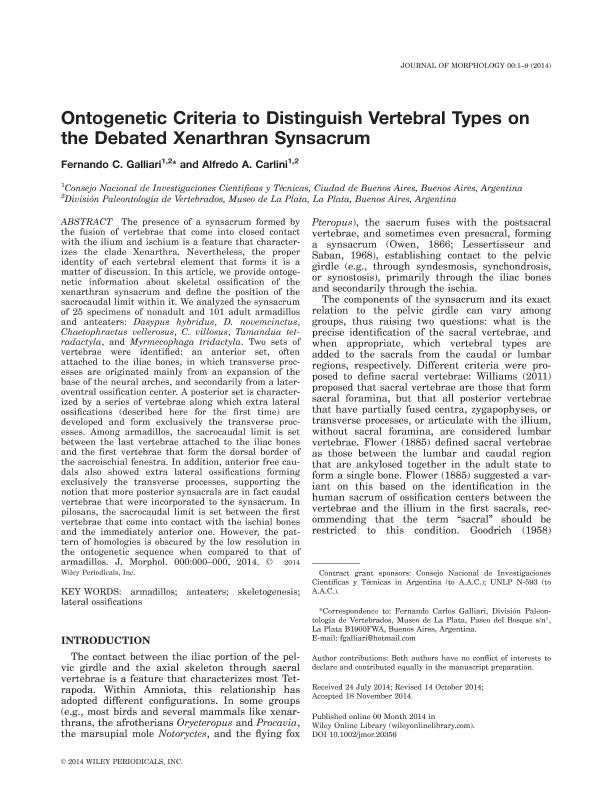Mostrar el registro sencillo del ítem
dc.contributor.author
Galliari, Fernando Carlos

dc.contributor.author
Carlini, Alfredo Armando

dc.date.available
2018-01-10T19:00:56Z
dc.date.issued
2014-11
dc.identifier.citation
Galliari, Fernando Carlos; Carlini, Alfredo Armando; Ontogenetic criteria to distinguish vertebral types on the debated xenarthran synsacrum; Wiley-liss, Div John Wiley & Sons Inc; Journal of Morphology; 274; 5; 11-2014; 494-502
dc.identifier.issn
0362-2525
dc.identifier.uri
http://hdl.handle.net/11336/32867
dc.description.abstract
The presence of a synsacrum formed by the fusion of vertebrae that come into closed contact with the ilium and ischium is a feature that characterizes the clade Xenarthra. Nevertheless, the proper identity of each vertebral element that forms it is a matter of discussion. In this article, we provide ontogenetic information about skeletal ossification of the xenarthran synsacrum and define the position of the sacrocaudal limit within it. We analyzed the synsacrum of 25 specimens of nonadult and 101 adult armadillos and anteaters: Dasypus hybridus, D. novemcinctus, Chaetophractus vellerosus, C. villosus, Tamandua tetradactyla, and Myrmecophaga tridactyla. Two sets of vertebrae were identified: an anterior set, often attached to the iliac bones, in which transverse processes are originated mainly from an expansion of the base of the neural arches, and secondarily from a lateroventral ossification center. A posterior set is characterized by a series of vertebrae along which extra lateral ossifications (described here for the first time) are developed and form exclusively the transverse processes. Among armadillos, the sacrocaudal limit is set between the last vertebrae attached to the iliac bones and the first vertebrae that form the dorsal border of the sacroischial fenestra. In addition, anterior free caudals also showed extra lateral ossifications forming exclusively the transverse processes, supporting the notion that more posterior synsacrals are in fact caudal vertebrae that were incorporated to the synsacrum. In pilosans, the sacrocaudal limit is set between the first vertebrae that come into contact with the ischial bones and the immediately anterior one. However, the pattern of homologies is obscured by the low resolution in the ontogenetic sequence when compared to that of armadillos.
dc.format
application/pdf
dc.language.iso
eng
dc.publisher
Wiley-liss, Div John Wiley & Sons Inc

dc.rights
info:eu-repo/semantics/openAccess
dc.rights.uri
https://creativecommons.org/licenses/by-nc-sa/2.5/ar/
dc.subject
Armadillos
dc.subject
Anteaters
dc.subject
Skeletogenesis
dc.subject
Lateral Ossifications
dc.subject.classification
Otras Ciencias Biológicas

dc.subject.classification
Ciencias Biológicas

dc.subject.classification
CIENCIAS NATURALES Y EXACTAS

dc.title
Ontogenetic criteria to distinguish vertebral types on the debated xenarthran synsacrum
dc.type
info:eu-repo/semantics/article
dc.type
info:ar-repo/semantics/artículo
dc.type
info:eu-repo/semantics/publishedVersion
dc.date.updated
2018-01-10T16:51:01Z
dc.journal.volume
274
dc.journal.number
5
dc.journal.pagination
494-502
dc.journal.pais
Estados Unidos

dc.journal.ciudad
New York
dc.description.fil
Fil: Galliari, Fernando Carlos. Consejo Nacional de Investigaciones Científicas y Técnicas; Argentina. Universidad Nacional de La Plata. Facultad de Ciencias Naturales y Museo. Departamento Científico de Paleontología de Vertebrados; Argentina
dc.description.fil
Fil: Carlini, Alfredo Armando. Consejo Nacional de Investigaciones Científicas y Técnicas; Argentina. Universidad Nacional de La Plata. Facultad de Ciencias Naturales y Museo. Departamento Científico de Paleontología de Vertebrados; Argentina
dc.journal.title
Journal of Morphology

dc.relation.alternativeid
info:eu-repo/semantics/altIdentifier/doi/http://dx.doi.org/10.1002/jmor.20356
dc.relation.alternativeid
info:eu-repo/semantics/altIdentifier/url/http://onlinelibrary.wiley.com/doi/10.1002/jmor.20356/abstract
Archivos asociados
